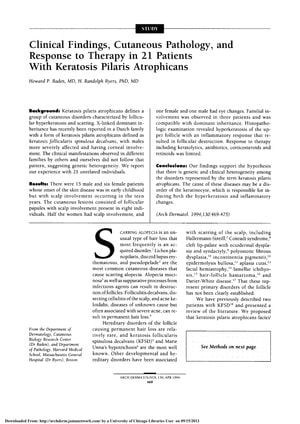Clinical Findings, Cutaneous Pathology, and Response to Therapy in 21 Patients With Keratosis Pilaris Atrophicans
April 1994
in “
Archives of dermatology
”
Keratosis Pilaris Atrophicans follicular hyperkeratosis scarring keratinocyte disorder hyperkeratosis inflammation keratolytics antibiotics corticosteroids retinoids genetic analysis cyclosporine KPA keratin disorder skin inflammation skin scarring skin thickening skin peeling agents antibacterial treatments steroid creams vitamin A derivatives genetic testing immunosuppressant

TLDR The study found that Keratosis Pilaris Atrophicans is a genetic skin condition that starts in childhood, involves inflammation and scarring, and current treatments are only somewhat effective.
The 1994 study on 21 patients with Keratosis Pilaris Atrophicans (KPA) revealed that the condition is characterized by follicular hyperkeratosis, scarring, and onset in early childhood, with scalp involvement typically in the teen years. The patient group included 15 males and 6 females, with 3 cases suggesting dominant inheritance. Histopathologic examination indicated that KPA may be caused by a keratinocyte disorder, leading to hyperkeratosis and inflammation, rather than solely by follicular damage. Treatments such as keratolytics, antibiotics, corticosteroids, and retinoids were only somewhat effective. Genetic analysis pointed to heterogeneity in KPA, with linkage to Xp21.2-p22.2 in one family. The study suggests exploring new treatments, but notes the difficulty in justifying long-term use of cyclosporine in a genetic disease.